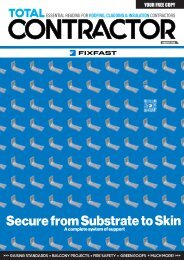August 2020
Create successful ePaper yourself
Turn your PDF publications into a flip-book with our unique Google optimized e-Paper software.
Building Passports
PASSPORT TO ENERGY EFFICIENCY?
As Simon Blackham, Technical Manager at Recticel Insulation, explains, “a building
passport would be a constructional blueprint of a property.” Below, he discusses how a
building passport would work, and how useful it might be in addressing issues relating to
the UK’s energy deficient housing stock.
Building Passports as a means of certifying
key information about a property are an
extension of recommendations made in
Dame Judith Hackitt’s review of building
regulations and fire safety. In the report, which
was published following the 2017 Grenfell Tower
tragedy, Dame Judith spoke of the need to create
a ‘golden thread’ of data about a building for a
supply chain of stakeholders from architects to
engineers, through to building safety managers
and end users. And whilst this ‘thread’ applied
specifically to high-rise buildings, it has given
credence to the idea that the same informative
package could be produced for regular housing.
So, how would a building passport work, and how
useful might it be in addressing issues relating to
the UK’s energy deficient housing stock?
In essence, a building passport would be a
constructional blueprint of a property. This would
include information such as the thermal
standards a property was built to – and that it
achieved those standards – and the type of
materials that were used to build it inside and
out. Accessible to housing and building
authorities, such data would be crucial to
ensuring all homes within a new development, for
example, were built to the same standard. It
would also provide householders with a clearlydefined,
certified baseline upon which to improve
on their home’s energy performance, should they
so wish.
Call to action
For easy accessibility, building passport data
would be held digitally. This would lead in all
probability to terabytes of information needing to
be stored securely but accessibly. This
information would need to be kept up to date
when changes to the building are
made, such as changing the
boiler or building an extension,
so it remains accurate and
relevant to the building.
“The necessary
renovation work is
nowhere near starting;
a fact which is made all
the more lamentable
by the persisting
instance of houses
being built to outdated
regulations”
The Insulation Manufacturer’s Association
estimates more than 3,400 homes would need to
be upgraded per day from now until 2035 in order
to meet the government’s target for EPC band C
for homes. Unfortunately, the necessary
renovation work is nowhere near starting; a fact
which is made all the more lamentable by the
persisting instance of houses being built to
outdated regulations. In my opinion, the
government should be tackling the issue of
Britain’s poorly-insulated homes with the same
vigour it applies to other public endeavours and
displays of national infrastructure investment.
Easy access
Having outlined the likely logistical issues
involved with processing and storing a huge
amount of building passport data, it is worth
pointing out that the information is already
available – it’s just a case of collating it. BIM,
EPC certificates, U-value calculations and
Simon Blackham, Recticel Insulation.
supporting data sheets are a
basis for modern housing
developments. If accessible in
one easily downloadable digital
space, this information would
make retrofitting or altering a
property to an acceptable standard a far
more straightforward prospect.
In her review of building regulations and fire
safety, Dame Judith makes it clear that the UK
construction industry requires a sea change in
culture and practice to improve its all-round
standards. Initiatives such as the building
passport would certainly represent a positive
break from tradition, as it would remove the
element of guesswork involved in increasing a
property’s energy efficiency. In knowing what a
home’s performance is to begin with, small
changes could be made to further improve it. And
small changes on a mass scale could make a
huge difference to the country’s emissions count.
The government has shown favour to Dame
Judith’s golden thread in relation to high-rise
buildings, so it’s hoped the same accord will be
bestowed upon a similar scheme for standard
properties. As stated, upgrading nearly 30 million
poorly-insulated UK homes represents an
almighty challenge. Therefore, the imminent issue
of building passports for new properties offers an
easier option. It would mean we wouldn’t be
adding to an already serious problem.
Contact Recticel Insulation
0800 085 4079
www.recticelinsulation.com
@RecticelInsulUK
50 TC AUGUST 2020

















